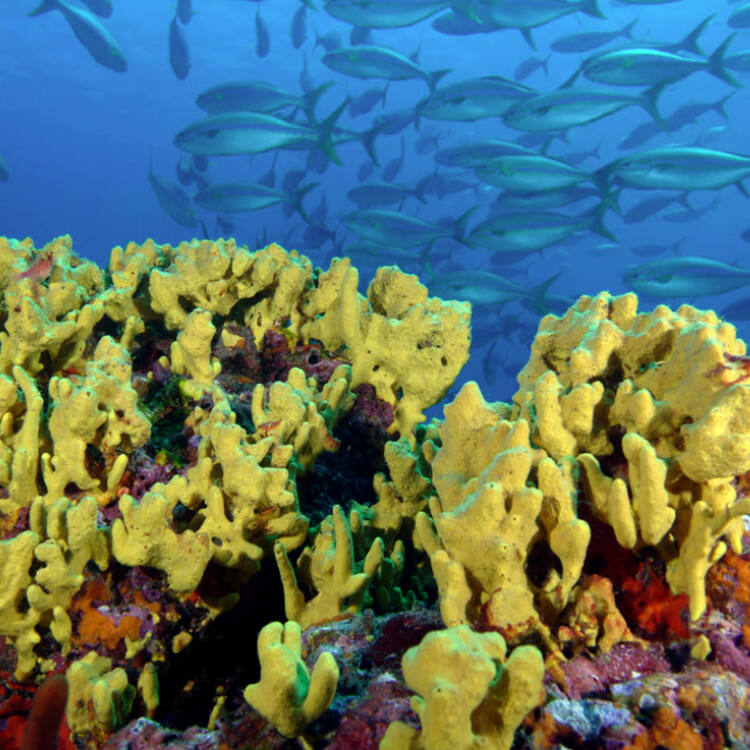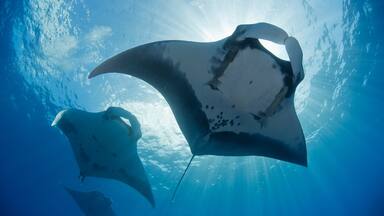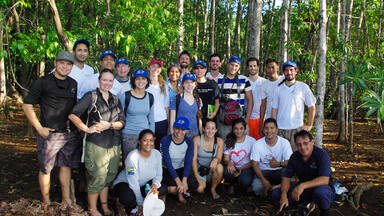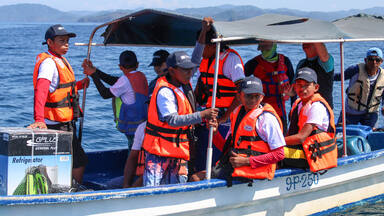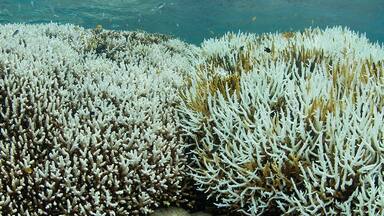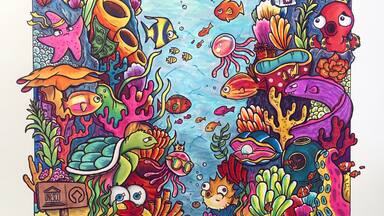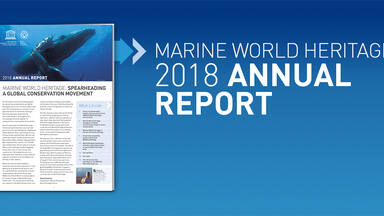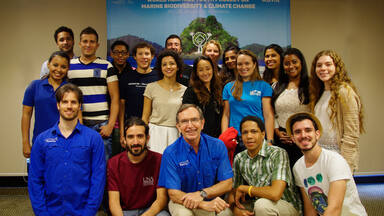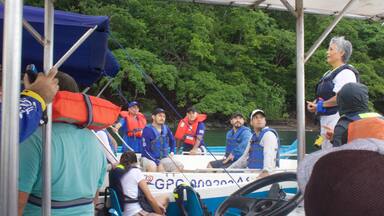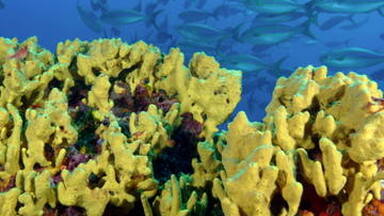Coiba National Park and its Special Zone of Marine Protection
Coiba National Park and its Special Zone of Marine Protection
Coiba National Park, off the southwest coast of Panama, protects Coiba Island, 38 smaller islands and the surrounding marine areas within the Gulf of Chiriqui. Protected from the cold winds and effects of El Niño, Coiba’s Pacific tropical moist forest maintains exceptionally high levels of endemism of mammals, birds and plants due to the ongoing evolution of new species. It is also the last refuge for a number of threatened animals such as the crested eagle. The property is an outstanding natural laboratory for scientific research and provides a key ecological link to the Tropical Eastern Pacific for the transit and survival of pelagic fish and marine mammals.
Description is available under license CC-BY-SA IGO 3.0
Parc national de Coiba et sa zone spéciale de protection marine
Le Parc national de Coiba, au large de la côte ouest du Panama, protège l’île de Coiba, 38 îlots et les zones marines environnantes dans le golfe de Chiriqui. Abritées des vents froids et des effets d’El Niño, les forêts tropicales humides du Pacifique de Coiba entretiennent un niveau d’endémisme exceptionnel pour les mammifères, les oiseaux et les plantes en raison de l’évolution en cours de nouvelles espèces. C’est le dernier refuge d’un certain nombre d’espèces menacées telles que la harpie huppée. Le bien est un laboratoire naturel exceptionnel pour la recherche scientifique et sert de lien écologique clé dans le Pacifique tropical oriental pour le transit et la survie de poissons pélagiques et de mammifères marins.
Description is available under license CC-BY-SA IGO 3.0
منتزه كويبا الوطني ومنطقة كويبا الخاصة للحماية البحرية
يوفّر منتز كويبا الوطني، في عرض بحر الساحل الغربي لباناما، حمايةً لجزيرة كويبا ومجموعة مؤلفة من 38 جزيرة صغيرة والمناطق البحرية المجاورة في خليج شيريكي. كما أن الغابات الاستوائيّة الرطبة الواقعة في المحيط الهادي لجزيرة كويبا، التي تنأى عن الهواء البارد وآثار إعصار النينيو، تؤمن مستوى استيطان استثنائي للثدييات والطيور والنباتات بفعل التطور الراهن للأنواع الجديدة. إنه الملجأ الأخير لعددٍ معيَّنٍ من الأنواع المهدَّدة كالخفاش ذي القنبرة، ومختبر طبيعي استثنائي للبحث العلمي. يوفّر هذا المنتزه رابطًا بيئيًّا أساسيًّا في المنطقة الاستوائية الشرقية للمحيط الهادي لتسهيل مرور الأسماك المحيطية والثدييات البحرية وبقائها حيَّة.
source: UNESCO/CPE
Description is available under license CC-BY-SA IGO 3.0
柯义巴岛国家公园及其海洋特别保护区
柯义巴岛国家公园远离巴拿马西南海岸,保护着柯义巴岛、38个小岛和奇里基湾内四周的海域。柯义巴的太平洋热带雨林没有受到冷风和厄尔尼诺影响,由于新物种的持续进化,它包含了极高水平的地方性哺乳动物、鸟类和植物。这还是像冠鹰一样的许多濒危动物的最后庇护所。这里是科学家进行研究的重要的自然实验室,并为远洋鱼和海洋哺乳动物的转移和生存提供了炎热的东部太平洋关键生态链。
source: UNESCO/CPE
Description is available under license CC-BY-SA IGO 3.0
Национальный парк Койба и его особо охраняемая акватория
Национальный парк Койба, располагающийся у юго-западного тихоокеанского побережья Панамы, включает крупный остров Койба, 38 более мелких островов, а также прилегающую акваторию в заливе Чирики. Будучи защищенными от прохладных ветров и испытывая воздействие теплого течения Эль-Ниньо, здешние влажнотропические леса поддерживают исключительно высокий уровень эндемизма среди млекопитающих, птиц и растений, причем процессы видообразования продолжаются и поныне. Парк служит последним убежищем для целого ряда исчезающих видов, например, для хищной птицы гарпии. Данный район представляет собой прекрасную естественную лабораторию для проведения научных изысканий, он имеет также ключевое значение для сохранения пелагических рыб и морских млекопитающих.
source: UNESCO/CPE
Description is available under license CC-BY-SA IGO 3.0
Parque Nacional de Coiba y su zona especial de protección marina
El Parque Nacional de Coiba, situado frente a la costa sudoeste de Panamá, en el Golfo de Chiriquí, protege la isla de Coiba y otras 38 islas e islotes menores, así como las zonas marinas circundantes. Amparado contra los vientos fríos y la corriente de El Niño, el bosque tropical húmedo de Coiba es un lugar de formación de nuevas especies, como lo demuestra el alto nivel de endemismo de muchos de sus mamíferos, pájaros y plantas. Último refugio de varias especies en peligro como el águila arpía, este sitio es un laboratorio natural excepcional para la investigación científica y un nexo ecológico fundamental en el Pacífico tropical oriental para el tránsito y la supervivencia de especies de peces pelágicos y mamíferos marinos.
source: UNESCO/CPE
Description is available under license CC-BY-SA IGO 3.0
コイバ国立公園とその海洋保護特別地帯
パナマの南西部に位置するコイバ国立公園は、コイバ島をはじめとする38の島々と、それを取り囲むチリキ湾の海域を保護している。コイバ島の海洋性熱帯雨林は、エルニーニョ現象による冷風の影響を受けることもなく現在も進化を続け、ここに生息する哺乳類や鳥類、植物は高い固有性を有している。ヒメオウギワシなどの希少種にとっては、最後の生息地となっている。また海洋保護区は、東太平洋とパナマ湾との接点にあたるため、外洋魚類や海生哺乳類にとっても重要な海域といってよい。source: NFUAJ
Nationaal park Coiba en de speciale mariene beschermingszone
Het nationaal park Coiba ligt langs de zuidwest kust van Panama en beschermt het eiland Coiba, 38 kleinere eilanden en de omliggende zeegebieden binnen de Golf van Chiriqui. Coiba’s tropische vochtige woud is beschermd tegen de koude wind en de effecten van El Niño, waardoor het een uitzonderlijke verscheidenheid kent van inheemse zoogdieren, vogels en planten als gevolg van de voortdurende evolutie van nieuwe soorten. Het is ook het laatste toevluchtsoord voor een aantal bedreigde diersoorten, zoals de kuifadelaar. Het park vormt verder een belangrijke ecologische verbinding naar de tropische oostelijke Stille Oceaan voor de doorvoer en het voortbestaan van pelagische vissen en zeezoogdieren.
Source: unesco.nl
Outstanding Universal Value
Brief synthesis
Coiba National Park and its Special Zone of Marine Protection, is located in the Republic of Panama in the Gulf of Chiriqui, in the western sector of the country. The property protects Coiba Island along with 38 smaller islands and the surrounding marine area and is immersed in the Tropical Eastern Pacific, forming part of the Tropical Eastern Pacific Marine Corridor (CMAR). It is the last refuge for a number of threatened animals and an essential area for migratory species, including the essentials for the maintenance of the ecological balance of the oceanic masses, and valuable habitat for cetaceans, sharks, sea turtles and a large variety of pelagic fish species of high importance to regional level fisheries.
The property contains marine environments that have characteristics of both a continental and oceanic influence, and include insular marine coastal and terrestrial island ecosystems. This wide range of environments and resulting habitats is a result of the property’s location, close to the edge of the continental platform and at the same time to the mainland. These features combine to produce landscapes of incomparable beauty that are home to an exceptionally high level of endemism for mammals, birds and plants. An outstanding natural laboratory, the property provides a key ecological link to the Tropical Eastern Pacific and an important area for scientific research.
The size and length of the property allows for the protection of a whole and healthy ecosystem that is one of the last major refuges for rare and endangered species of tropical America. The conservation of the property is the main objective of close cooperation between the several stakeholders that form the Coiba National Park’s Directors Board, the authority responsible for the governance and management of the property.
Criterion (ix): Despite the short time of isolation of the islands of the Gulf of Chiriquí on an evolutionary timeframe, new species are being formed, which is evident from the levels of endemism reported for many groups (mammals, birds, plants), making the property an outstanding natural laboratory for scientific research. Furthermore the Eastern Pacific reefs, such as those within the property, are characterized by complex biological interactions of their inhabitants and provide a key ecological link in the Tropical Eastern Pacific for the transit and survival of numerous pelagic fish as well as marine mammals.
Criterion (x): The forests of Coiba Island possess a high variety of endemic birds, mammals and plants. Coiba Island also serves as the last refuge for a number of threatened species that have largely disappeared from the rest of Panama, such as the Crested Eagle and the Scarlet Macaw. Furthermore the marine ecosystems within the property are repositories of extraordinary biodiversity conditioned to the ability of the Gulf of Chiriquí to buffer against temperature extremes associated to El Niño/Southern Oscilation phenomenon. The property includes 760 species of marine fishes, 33 species of sharks and 20 species of cetaceans. The islands within the property are the only group of inshore islands in the tropical eastern Pacific that have significant populations of trans-Pacific fishes, namely, Indo-Pacific species that have established themselves in the eastern Pacific.
Integrity
The boundaries of the property are legally defined and contain a core protection area, consisting of the Coiba National Park and a designated buffer area, providing an essential zoning system to safeguard the beauty of the area and protect its important natural values. It contains the necessary elements to ensure the permanence of the necessary processes for long-term conservation of the ecosystems and the unique biological diversity of the property. The property encompasses the Island of Coiba in its entirety, thus providing refuge for its endemic species as well as for species that have largely disappeared from mainland Panama. It is a large area whose boundaries encompass 430,825 ha, comprising a marine component covering oceanic ecosystems including continental environments, islands with abrupt topography and legal protection. Combined with difficult access in many areas the legal protection assists in keeping the property relatively unaltered and with minimal human intervention.
The existence and integration of other marine protected areas at both national and regional levels, provides additional contributions to the protection of the special values that make the property exceptional. A number of factors could threaten the integrity of it property’s attributes and require attention, such as illegal fishing, both in regards to scale and equipment used, introduced species and ecotourism development projects. Additionally, climatic changes could also affect the conservation of the ecosystems within the property.
Protection and management requirements
Coiba National Park encompasses over 270,125 ha of which 216,500 ha are marine and 53,625 ha are insular and include Coiba Island along with 38 smaller islands. The Special Zone of Marine Protection is included within the boundaries of the property as a buffer area to the core area of the National Park and encompasses an additional 160,700 ha. Combined the National Park and the SZMP includes 53,761 ha of terrestrial habitats and 377,064 ha of marine area. The property is protected under National Law 44, signed by the Legislative Assembly of the Republic of Panama on 26th July 2004, establishing Coiba National Park and a Special Zone of Marine Protection within the Gulf of Chiriqui. National Law 44 established the boundaries of the National Park along with its Zone of Marine Protection as well as the protection and management regulations for both of these areas.
The property is subject to national level management which is supported by the legal and institutional framework that allows for the execution of an innovative governance model, through cooperative and coordinated participation of different stakeholders. The National Park was created by Resolution No. 021 (1991) of the National Authority of the Environment and the property is operationally managed by the National Environmental Authority and administratively by both national and local authorities along with members of civil society such as environmental NGOs and productive sectors. This approach to management works towards ensuring the property has the basic funding requirements for its management. It also assists in achieving the management objective of ensuring the conservation, protection and continuity of the ecological processes. In order to achieve this it is necessary to maintain and promote coordinated and participatory environmental management among communities, national authorities, users and stakeholders.
Fishing pressures on both the Coiba National Park and the Special Zone of Marine Protection is one of the threats and impacts on the property and along with infrastructure development, agriculture, forest cutting, human settlements and exploration and exploitation of mineral resources, while strictly prohibited remain potential threats. These issues have been extensively addressed by the management authority, along with NGOs that support continued conservation efforts and require ongoing investment in regards to monitoring Escuchar Leer fonéticamente.
Tourism interest in the property has grown and is expected to increase with the number of visitors growing rapidly. Tourism activities include use of the beaches and coastal areas as well as underwater activities and need to be monitored and managed so as to prevent significant impacts on the property and its values. As with other Marine Protected Areas, both in the region and world wide, the property faces the threats and impacts resulting from climate change such as coral bleaching, stronger and more frequent hurricanes and sea level rise.
